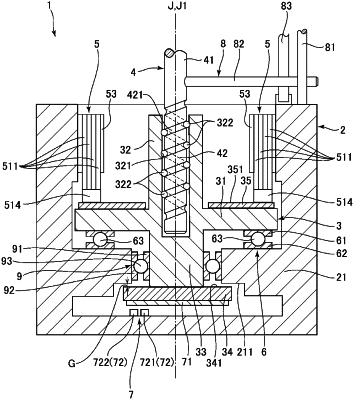| CPC F16H 25/2204 (2013.01) [F16H 25/2006 (2013.01); F16H 2025/204 (2013.01); F16H 2025/2075 (2013.01); F16H 2025/2081 (2013.01); F16H 2025/2084 (2013.01); H10N 30/20 (2023.02)] | 6 Claims |

|
1. A rotary-to-linear motion converter comprising:
a drive portion including
a vibrating portion vibrating by a piezoelectric body and
a convex portion coupled to the vibrating portion;
a housing;
a rotating member including
a first screw portion which has a tube shape and
a driven surface that contacts the convex portion and that receives driving force of the drive portion,
the rotating member pivoting around an axial center relative to the housing;
a base supporting the rotating member;
a linearly moving member including a columnar axial portion extending along a central axis and a second screw portion being provided at one end of the columnar axial portion along the central axis and inserted into the tubular first screw portion for threadably engaging with the first screw portion; and
a first restricting portion that is disposed at the housing and that is fixed to a driving end of the linearly moving member to restricts rotation of the linearly moving member,
wherein the driving end is the other end of the columnar axial portion opposite to the one end of the columnar axial portion,
wherein the first restricting portion includes a guide member that is fixed to the base and that extends along the central axis, a following member that is fixed to the linearly moving member and that extends in the direction orthogonal to the central axis, and a biasing member that biases the following member to press the following member against the guide member.
|